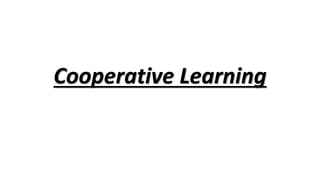
Cooperative learning
- 2. Definition • Cooperative learning is an educational situation where learning occurs while two or more students are working together to complete a common task (Siegel, 2005). • Cooperative learning is the structured, systematic instructional technique in which small groups work together to achieve a common goal (Slavin, 1991). • Cooperative learning enhances social interaction, which is essential to meet the needs of at-risk students (Slavin, Karweit, & Madden, 1989; Johnson, 1998).
- 3. Elements of cooperative learning • Johnson, Johnson, and Smith (1991) suggested that cooperative learning is more than simply “working in groups,” and should include the following: • Positive Interdependence • Individual Accountability • Face-to-face Interaction • Appropriate Use Of Collaborative Skills • Group Processing
- 4. Rationale • Encourages high student-teacher interaction • Develops cooperation and support among peers • Increases feedback and time on task • Respects diverse talents and ways of learning • Facilitates links to prior knowledge and sharing ideas • Enhances perspective-taking • Fosters problem-solving conflict management • Instills divergent thinking and risk-taking thinking • Utilizes resources and division of labor • Decreases fear of failure • Teacher as mentor and co-learner • Social view of knowledge and learning • Joint products and ownership
- 5. Rationale through Research • “Research has consistently found that students who gain most from cooperative work are those who give and receive elaborated explanations” (Gokhale, 1995, citing Webb, 1985). • “Students are capable of performing at higher intellectual levels when asked to work in collaborative situations than when asked to work individually. Group diversity in terms of knowledge and experience contributes positively to the learning process (Gokhale, 1995, citing Vygotsky, 1978). • “Bruner (1985) contends that cooperative learning methods improve problem-solving strategies because the students are confronted with different interpretations of the given situation. The peer support system makes it possible for the learner to internalize both external knowledge and critical thinking skills and to convert them into tools for intellectual functioning
- 6. Cont… • Group interaction helps students learn from each other’s scholarship, skills, and experiences. Students report that the benefits of learning in small groups include increased understanding, getting helpful feedback, the benefits of pooled knowledge and experience, stimulated thinking, gaining of new perspectives, more relaxed atmosphere which made problem- solving easier, a fun experience, new friends, and a greater sense of responsibility. Gokhale reported that if the purpose of instruction is to enhance critical thinking and problem-solving skills, rather than gaining factual knowledge, that collaborative learning is more beneficial (Gokhale, 1995). • For collaborative learning to be effective, the instructor must view teaching as a process of developing and enhancing students’ ability to learn. The instructor’s role in not to transmit information, but to serve as a facilitator for learning (Gokhale, 1995).
- 7. Advantages • Develops higher level thinking skills • Increases student retention • Builds self esteem in students • Enhances student satisfaction with the learning experience • Promotes a positive attitude toward the subject matter • Develops oral communication skills • Develops social interaction skills • Creates an environment of active, involved, exploratory learning • Uses a team approach to problem solving while maintaining individual accountability • Encourages diversity understanding • Stimulates critical thinking and helps students clarify ideas through discussion and debate • Enhances self management skills • Establishes an atmosphere of cooperation and helping
- 8. Disadvantages • A burden is making the students responsible for each other’s learning apart from themselves • One study showed that in groups of mixed ability, low-achieving students become passive and do not focus on the task • Depending on an individual’s motivation and interest on a particular subject that will determine how well they would learn • The goal of scaffolding is for students to become independent and able to think by themselves, without the help of others • High stakes create increased chances for conflict and therefore need for conflict resolution skills • It is difficult for the teacher to be sure that the groups are discussing the academic content rather than something else. • Higher ability students may not experience the stimulation or challenge that they would with other higher ability students. • Lower ability students may feel perpetually in need of help rather than experiencing the role of leader or expert relative to the others in their group
- 9. Types • FORMAL COOPERATIVE LEARNING is structured, facilitated, and monitored by the educator over time and is used to achieve group goals in task work (e.g. completing a unit). Any course material or assignment can be adapted to this type of learning, and groups can vary from 2-6 people with discussions lasting from a few minutes up to an entire period. • INFORMAL COOPERATIVE LEARNING incorporates group learning with passive teaching by drawing attention to material through small groups throughout the lesson or by discussion at the end of a lesson. These groups are often temporary and can change from lesson to lesson
- 10. Cont… • GROUP BASED LEARNING In group-based cooperative learning, these peer groups gather together over the long to develop and contribute to one another’s knowledge mastery on a topic by regularly discussing material, encouraging one another, and supporting the academic and personal success of group members. Base group learning is effective for learning complex subject matter over the course or semester and establishes caring, supportive peer relationships, which in turn motivates and strengthens the student’s commitment to the group’s education while increasing self-esteem and self- worth.
- 11. Procedure/Steps of Cooperative Learning • Pre-instructional planning • Introduce activity to the students • Monitor and intervene • Assessment • Process